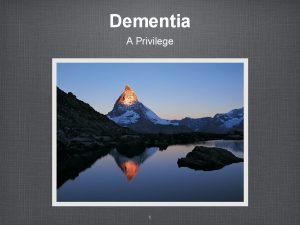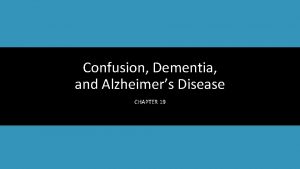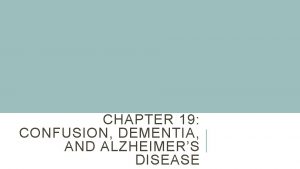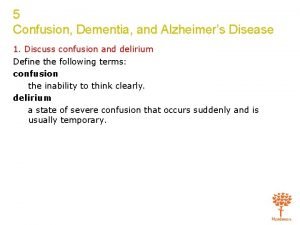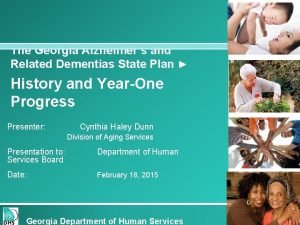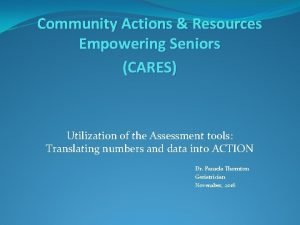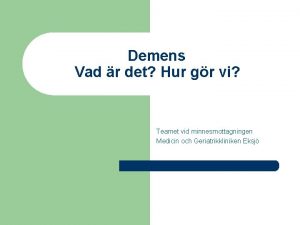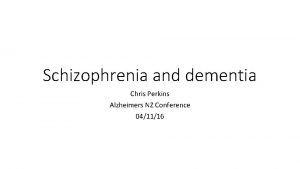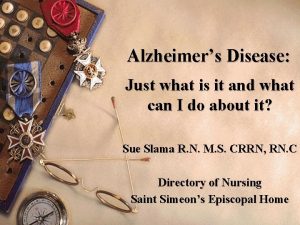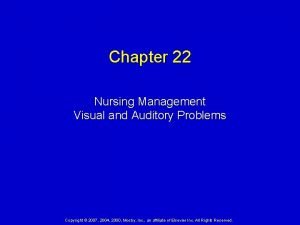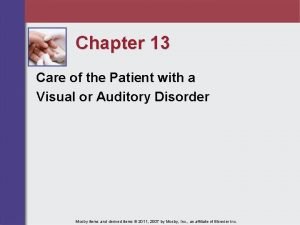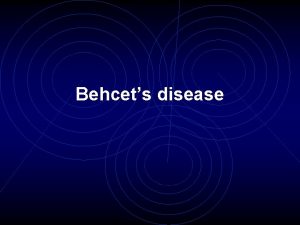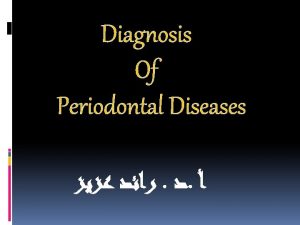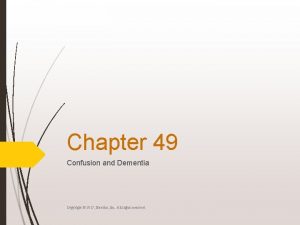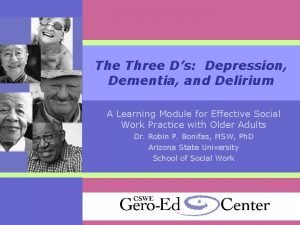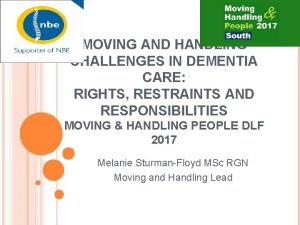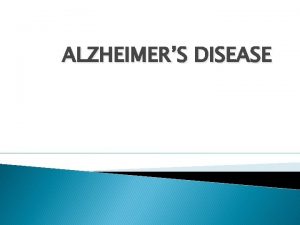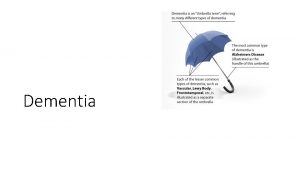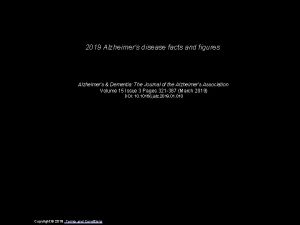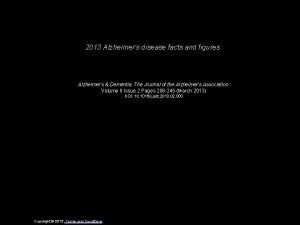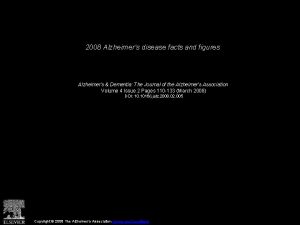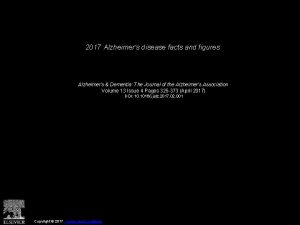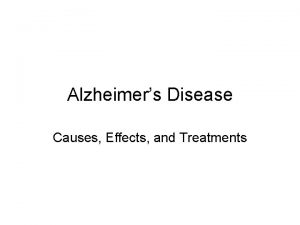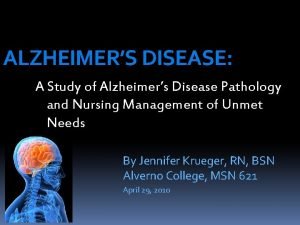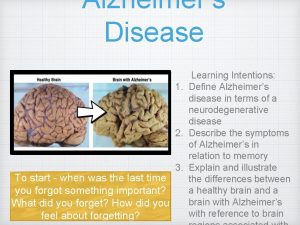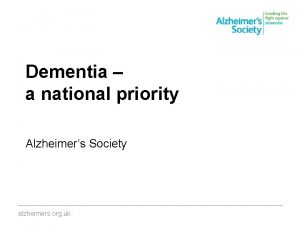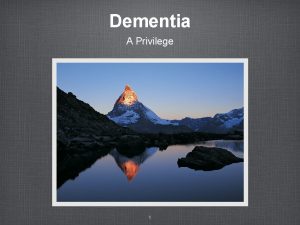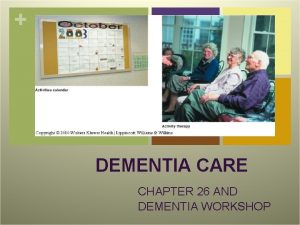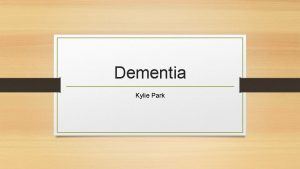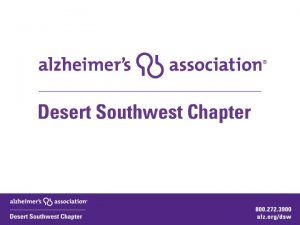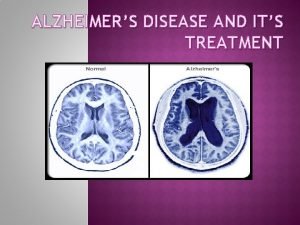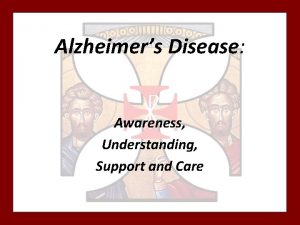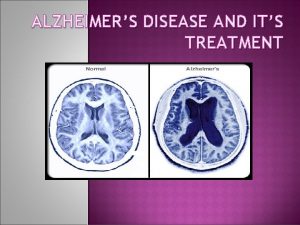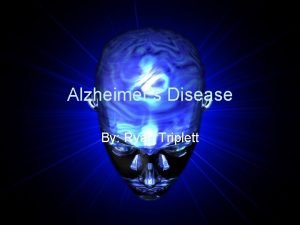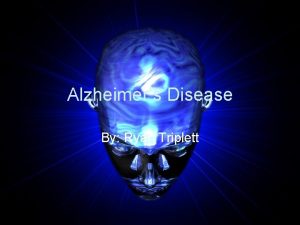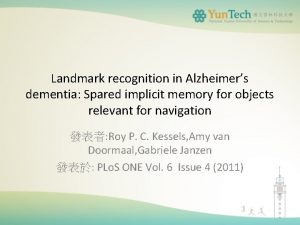Dementia and Alzheimers Disease Recognition and Diagnosis J
























- Slides: 24

Dementia and Alzheimer’s Disease: Recognition and Diagnosis J. Wesson Ashford, M. D. , Ph. D. Stanford / VA Alzheimer’s Center VAMC, Palo Alto California May 5, 2006 Slides at: www. medafile. com (Dr. Ashford’s lectures)

Dementia Definition • Multiple Cognitive Deficits: – Memory dysfunction • especially new learning, a prominent early symptom – At least one additional cognitive deficit • aphasia, apraxia, agnosia, or executive dysfunction • Cognitive Disturbances: – Sufficiently severe to cause impairment of occupational or social functioning and – Must represent a decline from a previous level of functioning

Alzheimer’s Disease • First described by Alois Alzheimer, a German neuropathologist, in 1907 • Observed in a 51 -year-old female patient with paranoia, memory loss, disorientation, and hallucinations • Postmortem studies characterized senile plaques and neurofibrillary tangles (NFTs) in the cerebral cortex – Senile plaques: Extracellular accumulation of insoluble fragments of beta-amyloid (A 1 -42) – NFTs: Intracellular accumulation of hyperphosphorylated tau strands

Relative Risk Factors for Alzheimer’s Disease • • • Family history of dementia Family history - Downs Family history - Parkinson’s Maternal age > 40 years Head trauma (with LOC) History of depression History of hypothyroidism History of severe headache History of “statin” use NSAID use – Use of NSAIDs, ASA, H 2 -blcks 3. 5 (2. 6 - 4. 6) 2. 7 (1. 2 - 5. 7) 2. 4 (1. 0 - 5. 8) 1. 7 (1. 0 - 2. 9) 1. 8 (1. 3 - 2. 7) 2. 3 (1. 0 - 5. 4) 0. 7 (0. 5 - 1. 0) 0. 3 0. 2 (0. 05 – 0. 83) 0. 09 Roca, 1994; ‘t Veld et al. , 2001, Breitner et al. , 1998, Wolozin et al. , 2000

Epidemiology of AD • Prevalence estimate 4 million cases in US (2000) • (2000 - 46 million individuals over 60 y/o) • Incidence estimate 500, 000 new cases per year • Doubles every 5 years (see Jorm & Jolley, 1998) • Increase with age – – – – 1% of 2% of 4% of 8% of 16% of 32% of 64% of 60 - 65 (10. 8 m) 65 - 70 ( 9. 5 m) 70 - 75 ( 8. 9 m) 75 - 80 ( 7. 4 m) 80 - 85 ( 4. 9 m) 85 – 90 ( 2. 8 m) 90 - 95 ( 1. 1 m) prevalence incidence = = = = 108, 054 191, 000 354, 000 593, 000 791, 000 893, 000 712, 000 13, 000 23, 000 42, 000 70, 000 92, 000 102, 000 89, 000

ECONOMIC IMPACT OF AD • 2 million AD patients in nursing homes in U. S. – Projection to California (2005) – 240, 000 • Nursing Home Care of AD patients - costs – $40, 000/year in U. S. = $80 billion per year – $55, 000/year in California (2005) = $13 billion per year – Average patient is in nursing homes for an average of about 3 years – Life-time nursing home cost (CA) – about $165, 000 per patient avg. • The majority of patients live at home and are cared for by family and friends • With lost wages of patients and families plus costs for non-nursing home patients: – Total costs in U. S. : $120 billion annually (Am J Publ Hlth) – Projection to California – $20 billion annually!

United States, 440 Congressional Districts

Benefits of Early Alzheimer Diagnosis Social • Undiagnosed AD patients face avoidable problems • social, financial • Early education of caregivers • how to handle patient (choices, getting started) • Advance planning while patient is competent • will, proxy, power of attorney, advance directives • Reduce family stress and misunderstanding • caregiver burden, blame, denial • Promote safety • driving, compliance, cooking, etc. • Patient’s and Family’s right to know • especially about genetic risks • Promote advocacy • for research and treatment development

Benefits of Early Alzheimer Diagnosis Medical • Early diagnosis and treatment and appropriate intervention may: – improve overall course substantially – lessen disease burden on caregivers / society • Specific treatments now available (anti-cholinesterases, memantine) – Improve cognition – Improve function (ADLs) – Delay conversion from Mild Cognitive Impairment to AD – Slow underlying disease process, the sooner the better – Decreased development of behavior problems – Delay nursing home placement, possibly over 20 months – Delay nursing home placement longer if started earlier

AD is Under-diagnosed • Early Alzheimer’s disease is subtle, the diagnosis continues to be missed – it is easy for family members to avoid the problem and compensate for the patient – physicians tend to miss the initial signs and symptoms • Less than half of AD patients are diagnosed – Estimates are that 25% to 50% of cases remain undiagnosed – Diagnoses are missed at all levels of severity: mild, moderate, severe • Undiagnosed AD patients often face avoidable social, financial, and medical problems • Early diagnosis and appropriate intervention may lessen disease burden – Early treatment may improve overall course substantially • No definitive laboratory test for diagnosing AD exists – Efforts to develop biomarkers, early recognition by brain scan Evans DA. Milbank Quarterly. 1990; 68: 267 -289

Need to Develop Better Tools for Early Assessment • Genetic vulnerability testing (trait risk) • Vulnerability factors (education, occupation, head injury) • Early recognition (10 warning signs) – Activities of Daily Living (ADLs), behavior changes, forgetting • Developing suspicion - screening tools – 6 th vital sign in elderly • Positive diagnostic tests – CSF (cerebrospinal fluid) – tau levels elevated, amyloid levels low – Brain scan – PET – DDNP, Congo-red derivatives • Mild Dementia severity assessments • Detecting early change over time – measuring rate, predicting progression

Alzheimer Warning Signs Top Ten Alzheimer Association 1. Recent memory loss affecting job 2. Difficulty performing familiar tasks 3. Problems with language 4. Disorientation to time or place 5. Poor or decreased judgment 6. Problems with abstract thinking 7. Misplacing things 8. Changes in mood or behavior 9. Changes in personality 10. Loss of initiative


JW Ashford, MD Ph. D, 2001

Brief Alzheimer Screen (BAS) • Repeat these three words: “apple, table, penny”. • So you will remember these words, repeat them again. • What is today’s date? • D = 1 if within 2 days. • Spell the word “WORLD” backwards • S = 1 point for each word in correct order • “Name as many animals as you can in 30 seconds, GO!” • A = number of animals • “What were the 3 words I asked you to repeat? ” (no prompts) • R = 1 point for each word recalled BAS = 3 x R + 2/3 x A + 4. 75 x D + 2 x S www. medafile. com/BAS Mendiondo et al. , J Alz Dis 5: 391, 2003

JW Ashford, MD Ph. D, 2001

JW Ashford, MD Ph. D, 2003

$W = Cost–Worthiness Calculation • • • I = incidence (new occurrences each year, by age) $T = cost of test, time to take (Subject, Tester) Se = sensitivity of test = True positive / I Sp = specificity of test = True negative / (1 -I) Cost: – $B = benefit of a true positive diagnosis • Estimate: (100 years – age ) x $1000 • Save $50, 000 NH cost / 1 year (after treatment cost deduction) – $C = cost of a false positive diagnosis • $500 for further evaluation (time, stress of suspecting dementia) – True negative (real peace of mind) (no money) – False negative = false peace of mind (no price) $W = ($B x I x Se) – ($C x (1 -I) x (1 -Sp)) - $T Kraemer, Evaluating Medical Tests, Sage, 1992

Diagnostic Criteria For Dementia Of The Alzheimer Type (DSM-IV, APA, 1994) A. Memory Impairment 1. Multiple Cognitive Deficits 2. Other Cognitive Impairment B. Deficits Impair Social/Occupational C. Course Shows Gradual Onset And Decline D. Deficits Are Not Due to: 1. Other CNS Conditions 2. Substance Induced Conditions E. Do Not Occur Exclusively during Delirium F. Not Due to Another Psychiatric Disorder

Full Dementia Assessment – 1 hour ð History Of Dementia Development (30 min) ð ð ð ð Ask the Patient What Problem Has Brought Him to See You Ask the Family, Companion about the Problem Specifically Ask about Memory Problems Ask about the First Symptoms Enquire about Time of Onset Ask about Any Unusual Events Around the Time of Onset, e. g. , stress, trauma, surgery Ask about Nature and Rate of Progression, Activities of Daily Living Physical Examination (5 minutes) ð Neurological Examination (5 minutes) (vibration sense) ð Neuropsychological Assessment (20 minutes) ð Routine Laboratory Tests ð Brain Scan (CT at minimum, add PET optimally) ð

LABORATORY TESTS (routine) • BLOOD TESTS – electrolytes, liver, kidney function tests, glucose – thyroid function tests (T 3, T 4, FTI, TSH) – vitamin B 12, folate (consider homocysteine) – complete blood count, ESR – VDRL, HIV (if indicated) • EKG (if indicated) • CHEST X-RAY (if indicated) • URINALYSIS • ANATOMICAL BRAIN SCAN – CT (cheaper ? ), MRI – Scripps = $880 (min); Modesto = $6, 600 (max) • Functional Brain Scan – SPECT / PET – PET approved by Medicare for differential from fronto-temporal

Differential Diagnosis: Top Ten (commonly used mnemonic device: AVDEMENTIA) 1. Alzheimer Disease (pure ~40%, + mixed~70%) 2. Vascular Disease, MID (5 -20%) 3. Drugs, Depression, Delirium 4. Ethanol (5 -15%) 5. Medical / Metabolic Systems 6. Endocrine (thyroid, diabetes), Ears, Eyes, Environment 7. Neurologic (other primary degenerations, etc. ) 8. Tumor, Toxin, Trauma 9. Infection, Idiopathic, Immunologic 10. Amnesia, Autoimmune, Apnea, AAMI Adapted from Yesavage, 1979

Alzheimer’s Disease versus Dementia – 50 - 70% of dementias are due to AD – Probable AD - 30% of cases, 90% neuropath - correct – 20% have other contributing diagnoses – Possible AD - 40% of cases, 70% are AD at neuropath – 40% have other contributing diagnoses – Unlikely AD - 30% of cases, 30% are AD at neuropath – 80% have other contributing diagnoses – Alzheimer’s disease is a pathological condition – Dementia is a clinical condition frequently caused by AD • The AD dementia has some characteristics and some heterogeneity

THE TOP TEN TREATMENTS FOR PREVENTING ALZHEIMER’S DISEASE www. medafile. com 1. Take blood pressure regularly, assure systolic pressure is always < 130. 2. Watch your cholesterol; if cholesterol is above 200, talk to your clinician about treatment. Consider “statin” medications. Increase dietary intake of omega-3 -fatty acids. Add deep sea fish, nuts, olives. Avoid excess red meat, animal products. 3. Exercise your body, mind, and spirit regularly. Physical exercise best 10 -30 mins after each meal for 10 -30 minutes, 3 times per day. Maximize your education. Do mental puzzles (like crossword puzzles). Stay active. 4. Physically protect your brain. Wear your car seat-belt. Wear a helmet when riding a bicycle or participating in activity where you might hit your head. 5. Decrease your risk of type II diabetes. Monitor your fasting blood sugar yearly. Keep your BMI (Basal Metabolic Index) in the optimal range (19 -25) by controlling food intake and exercise. If you have diabetes, make sure that blood sugar is controlled. 6. Consult your clinician about pains (treat arthritis with ibuprofen, sulindac, or indocin). 7. Take your vitamins daily (folate - 400 mcg, B 12 - 25 mcg, C - 250 mg, and E 200 iu's). Check yearly that your homocysteine levels are low and no signs of B 12 deficiency. Eat your veggies. 8. Discuss sex-hormone replacement therapy with your clinician. 9. For sleep difficulty, try 3 - 6 milligrams of melatonin at bedtime. 10. Monitor your memory regularly. If you have significant difficulty with your memory, talk to your clinician. Consider therapy with cholinesterase inhibitors and memantine.
 Alzheimers society contented dementia
Alzheimers society contented dementia Chapter 19 confusion dementia and alzheimer's disease
Chapter 19 confusion dementia and alzheimer's disease Chapter 19 confusion dementia and alzheimer's disease
Chapter 19 confusion dementia and alzheimer's disease Confusion dementia and alzheimer's disease
Confusion dementia and alzheimer's disease A helpful way for an na to respond to hallucinations is to
A helpful way for an na to respond to hallucinations is to Potential nursing diagnosis
Potential nursing diagnosis Medical diagnosis and nursing diagnosis difference
Medical diagnosis and nursing diagnosis difference Nursing diagnosis three parts
Nursing diagnosis three parts Nursing process objectives
Nursing process objectives Georgia alzheimers planning
Georgia alzheimers planning Fast score dementia
Fast score dementia Vaskulär demens
Vaskulär demens Alzheimers nz conference 2020
Alzheimers nz conference 2020 Site:slidetodoc.com
Site:slidetodoc.com Alzheimers eye test joke
Alzheimers eye test joke Communicable disease and non communicable disease
Communicable disease and non communicable disease Perbedaan diagnosis gizi dan diagnosis medis
Perbedaan diagnosis gizi dan diagnosis medis Nursing diagnosis for vision impairment
Nursing diagnosis for vision impairment Nursing diagnosis for meniere's disease
Nursing diagnosis for meniere's disease Behcet disease diagnosis
Behcet disease diagnosis Diagnosis of periodontal disease
Diagnosis of periodontal disease 3 zones of human awareness
3 zones of human awareness Chapter 49 confusion and dementia
Chapter 49 confusion and dementia Difference between dementia and delirium
Difference between dementia and delirium Moving and handling dementia patients
Moving and handling dementia patients
